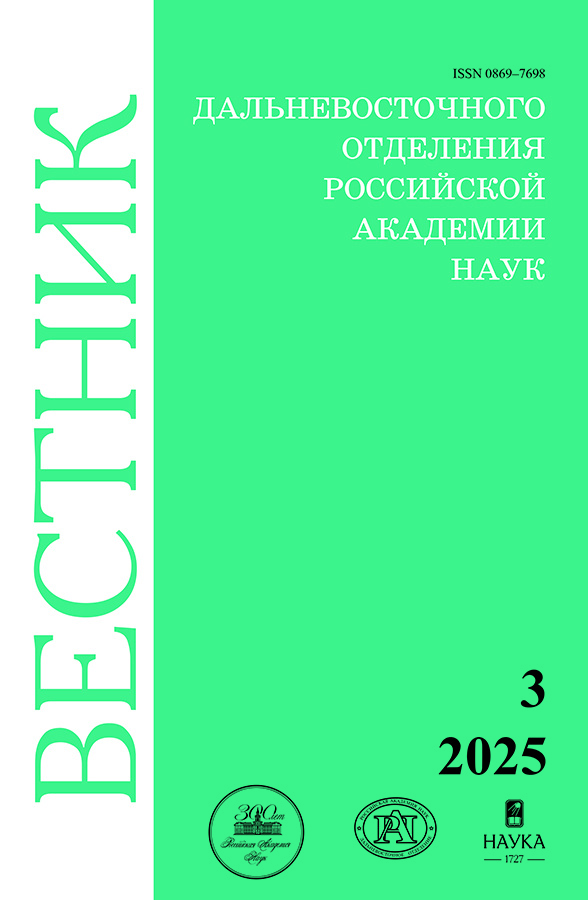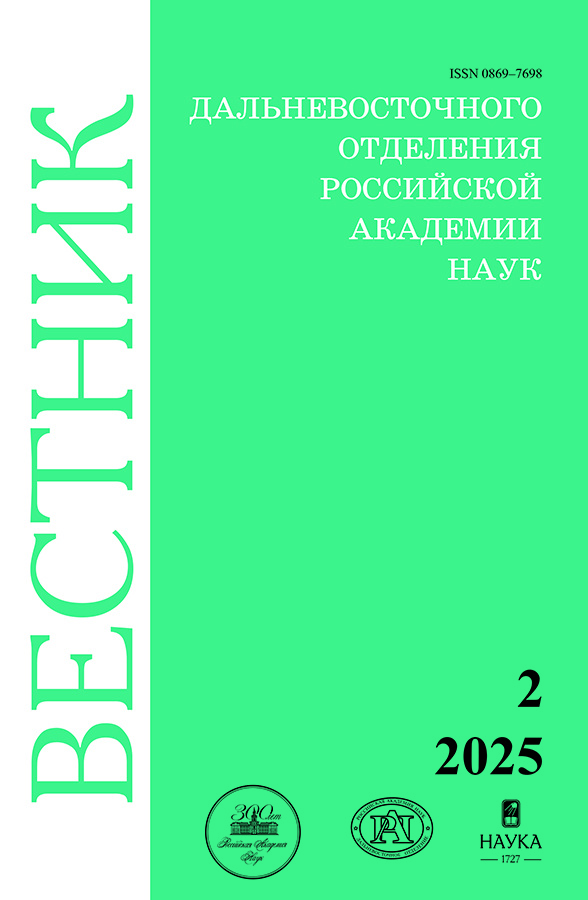Discovery of a new species Flaccisagitta yamato sp. nov. (Chaetognatha, Sagittoidea) and features of water circulation in the Yamato Rise region of the Sea of Japan
- Authors: Kasatkina A.P.1, Lobanov V.B.1, Sergeev A.F.1
-
Affiliations:
- V.I. Il’ichev Pacific Oceanological Institute, FEB RAS
- Issue: No 2 (2025)
- Pages: 76-89
- Section: Earth and Environment Sciences
- URL: https://permmedjournal.ru/0869-7698/article/view/687250
- DOI: https://doi.org/10.31857/S0869769825020069
- EDN: https://elibrary.ru/GEWGMB
- ID: 687250
Cite item
Full Text
Abstract
In the central Japan Sea, above the underwater Yamato Rise, chaetognaths (Chaetognatha, Sagittoidea) were discovered. Study of the anatomy of the specimens revealed the presence of saclike gelatinous structures (SG/S/), which indicates their belonging to the subfamily Flaccisagittinae. The features of the newly discovered species of Flaccisagitta are the distribution of fins on the body, the shape of the ciliated loop, the presence of peculiarly located ray structures and seminal vesicles relative to the caudal fin. The new species for science was named after the place of discovery above the Yamato Rise Flaccisagitta yamato sp. nov. The uniqueness of the discovery lies in the distribution of the new species – it was found only in the waters above the Yamato Rise. Hydrological data are presented on a possible explanation of the distribution of the new species, its discovery in the central part of the Sea of Japan. Modern data on the movement of water masses obtained as a result of expeditionary research and observations from space are presented, which allow us to assume the reasons for the existence of this species above the Yamato Rise.
Full Text
About the authors
Alla P. Kasatkina
V.I. Il’ichev Pacific Oceanological Institute, FEB RAS
Email: apkas@mail.ru
ORCID iD: 0000-0002-8004-9511
Doctor of Sciences in Biology, Leading Researcher
Russian Federation, VladivostokVyacheslav B. Lobanov
V.I. Il’ichev Pacific Oceanological Institute, FEB RAS
Email: lobanov@poi.dvo.ru
ORCID iD: 0000-0001-9104-5578
Candidate of Sciences in Geography, Head of Laboratory
Russian Federation, VladivostokAleksandr F. Sergeev
V.I. Il’ichev Pacific Oceanological Institute, FEB RAS
Author for correspondence.
Email: sergeev@poi.dvo.ru
ORCID iD: 0000-0003-4247-0791
Senior Researcher
Russian Federation, VladivostokReferences
- Nagai N., Tadokoro K., Kuroda K., Sugimoto T. Chaetognath species-specific responses to climate regime shifts in the Tsushima Warm Current of the Japan Sea. Plankton Benthos Res. 2008;3:86–95.
- Kitou M. Chaetognaths collected on the fifth cruise of the Japanese Expedition of deep seas. La Mer. 1966;4:169–177.
- Choo S., Jeong M.-K., Soh H.Y. Taxonomic reassessment of chaetognaths (Chaetognatha, Sagittoidea, Aphragmophora) from Korean waters. ZooKeys. 2022;1106:165–211. https://doi.org/10.3897/zookeys.1106.80184.
- Kasatkina A.P., Stolyarova M.V. Morfologiya, sistematika, ekologiya shchetinkochelyustnikh Japonskogo morya i sopredelnikh akvatoriy = [Morphology, systematic, ecology of bristle-jaws of the Japan Sea and adjacent regions]. Vladivostok: Dal'nauka; 2010. 200 p. (In Russ.).
- Park K.-A., Park J.-E., Choi B.-J., Byun D.-S., Lee E.-I. An Oceanic Current Map of the East Sea for Science Textbooks Based on Scientific Knowledge Acquired from Oceanic Measurements. J. Korean Soc. Oceanogr. 2013;18(4):234–265.
- Zenkevich N.L., Medvedev V.S., Skornyakova N.S. Main features of the geology and hydrology of the Sea of Japan. Moscow: Publishing house of the USSR Academy of Sciences; 1961. 224 p. (In Russ.).
- Preller R.H., Hogan P.J. Oceanography of the Sea of Okhotsk and the Japan/East Seas. In: The Sea. John Wiley and Sons Inc.; 1998. Vol. 11. P. 429–481.
- Vasil’yev A.S., Kosarev A.N., Terziyev F.S. (Eds.) Gidrometeorologiya i gidrokhimiya morey. T. 8. Yaponskoye more. Vyp. 1. Gidrometeorologicheskiye usloviya. St. Petersburg: Gidrometeoizdat, 2003. 394 p. = [Hydrometeorology and hydrochemistry of the seas. Vol. 8, Sea of Japan. Part 1. Hydrometeorological conditions]. St. Petersburg: Gidrometeoizdat; 2003. 394 p. (In Russ.)
- Morimoto A., Yanagi T., Kaneko A. Eddy field in the Japan Sea derived from satellite altimetric data. J. Oceanogr. 2000;56:449–462.
- Zhabin I.A., Dmitriyeva Ye.V., Taranova S.N., Lobanov V.B. Tsirkulyatsiya vod i mezomasshtabnyye vikhri v Yaponskom more po dannym sputnikovoy al’timetrii = [Water circulation and mesoscale eddies in the Sea of Japan based on satellite altimetry data]. Earth Research from Space. 2023;(6):52–72. (In Russ.).
- Kassatkina A.P. New species of the genus Sagitta s. str. (Chaetognatha) from the Sea of Japan with the original methods of the coloring and dissection technique. Zoosystematica Rossica. 2008;17(1):3–6.
- Schlitzer, 2019. Ocean data view. URL: http://odv.awi.de (date of application: January 20, 2025).
- Kassatkina A.P. New species of Aidanosagitta from the northwestern part of the Sea of Japan. Biol. Morya (English translation: Russ. J. Mar. Biol.). 2007;33(4):272–277. (In Russ.).
- Tokioka T. The taxonomical outline of Chaetognatha. Publ. Seto Mar. Biol. Lab. 1965;12(5):335–357.
- Germain L., Joubin L. Chaetognathes. Prince Albert Result. Camp. Sci. 1916;49:1–118.
- Kasatkina A.P. Novyye neriticheskiye shchetinkochelyustnyye iz zaliva Pos’yeta Yaponskogo morya = [New neritic species of chaetognaths from the Posjiet Bay, the Sea of Japan]. Issledovaniye Fauny Morey. 1971;8:265–294 (In Russ.).
- Kassatkina A.P. Finding of new species of finless sagittids (Sagittidae: Chaetognatha) in the northwestern Sea of Japan. Biol. Morya. 2006;32(6):415–420. (In Russ.; English translation: Russ. J. Mar. Biol. 32(6):353–359).
- Orbigny A.D., ď. Mollusken. In: Voyage dans l’Amerique meridionale. 1834–1835. 1843. Bd. 5, Teil 3. S. 1–140.
- Ritter-Záhony R. Revision der Chaetognathen. Deutsche Südpolar Expedition. 1911;13(5):1–71.
- Ritter-Záhony R. Chaetognatha. In: Ergebnisse der Plankton Expedition der Humboldt Stiftung. 1911. Bd. 2, No. 25. S. 1–33.
- Kassatkina A.P. Khetognaty morey SSSR i sopredel’nykh vod = [Chaetognaths of the USSR seas and adjacent waters]. Leningrad: Nauka; 1982. 136 s. (In Russ.).
- Grassi B. Chetognati. Fauna, Flora Neapoli. 1883;5:1–145.
- Casanova J.-P. Sagitta lucida et Sagitta adenensis. Chaetognathes mesoplanctoniques nouveaux du nord-ouest de l’ocean Indien. Rev. Inst. Peches Marit. 1983–1985;47(1 et 2):25–35.
- Yarichin V.G. Sostoyaniye izuchennosti tsirkulyatsii vod Yaponskogo moray = [State of knowledge of the water circulation of the Sea of Japan]. Proceedings of DVNIGMI. 1980;80:46–61. (In Russ.).
- Danchenkov M.A., Lobanov V.B., Riser S.C., Kim K., Takematsu M., Yoon J.-H. A history of physical oceanographic research in the Japan/East Sea. Oceanography. 2006;19(3):18–31.
- Isoda Y., Naganobu M., Watanabe H., Nukata K. Horizontal and vertical structures of a warm eddy above the Yamato Rise. Umi no Kenkyu. 1992;1:141–151. (In Japanese with English abstract).
- Nikitin A.A., Lobanov V.B., Danchenkov M.A. Vozmozhnyye puti perenosa teplykh subtropicheskikh vod v rayon Dal’nevostochnogo morskogo zapovednika = [Possible routes of transfer of warm subtropical waters to the area of the Far Eastern Marine Reserve]. Izvestiya TINRO (Pacific Research Fisheries Center). 2002;131:41–53 (In Russ.).
- Nikitin A.A., Danchenkov M.A., Lobanov V.B., Yurasov G.I. Novaya skhema poverkhnostnoy tsirkulyatsii Yaponskogo morya s uchetom sinopticheskikh vikhrey = [New scheme of surface circulation of the Sea of Japan taking into account synoptic eddies]. Izvestiya TINRO (Pacific Research Fisheries Center). 2009;157:158–167. (In Russ.).
- Lobanov V.B., Ponomarev V.I., Salyuk A.N., Tishchenko P.YA., Telli L.D. Struktura i dinamika sinopticheskikh vikhrey severnoy chasti Yaponskogo morya = [Structure and dynamics of synoptic eddies in the northern part of the Sea of Japan]. In: Far Eastern Seas of Russia. Oceanological studies. Moscow: Nauka; 2007. P. 450–473. (In Russ.).
- Gordon A.L., Giulivi C.F., Lee C. M., Bower A, Furey H.H., Talley L.D. Japan/East Sea Intra-thermocline eddies. J. Phys. Oceanogr. 2002;32(6):1960–1974.
Supplementary files














